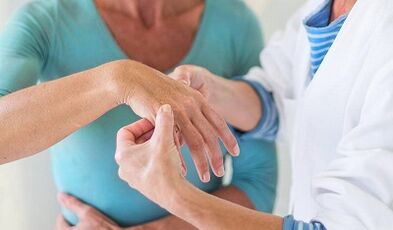Arthrosis and arthritis are diseases in which joints are affected.Because the names of this disease are consonant, many people have thoughts about their identity.They consider these terms as synonyms, showing that this is the same disease.However, arthrosis and arthritis are far from the same, and there are significant differences among it.To understand how arthrosis is different, let's find out what this disease is.
What is arthritis?
Arthritis is a collective term which means inflammation of any joint and most often shows a wider and serious pathological disorder in the body.That is, the disease is inflammation and can impress well and a few joints.
There are a number of diseases accompanied by the development of arthritis:
- rheumatic;
- gout;
- rheumatoid arthritis;
- Lupus Erythematosus Systemic;
- psoriasis;
- Hemhramatosis.
In addition, there are reactive joint arthritis that develop as a result of complications after infectious diseases:
- flu;
- syphilis;
- gonorrhea;
- micoplasmosis;
- Chlamydia.
All of these diseases are released in separate groups.
The inflammatory process for arthritis mainly affects synovial shells, and synovial fluids, causing disease (synovitis).As a result, the amount of liquid increases, which is interpreted by the swelling of the affected joints.Cartilage that covers the surface of the bone is also inflamed, and over time erosion that expresses the bone forms on it.
What is arthrosis?

Arthrosis is a non -inflammatory dystrophic disease, which is associated with deformation and destruction of cartilage tissue in the joints.Namely, pathological changes occur, which are manifested by cartilage dystrophy lining the surface of the bone.Although sometimes it is a long -term inflammatory process that triggers thinning and damage to the cartilage.Arthrosis is often observed in the elderly, because they use cartilage tissue with age, and also osteoporosis occurs, which negatively affects the condition of all supporters and motor equipment.
In some cases, arthrosis can occur at a young age in people who experience long loads in the joints.This category includes athletes, people who suffer from obesity or people whose professional activities lead to the rapid wear of the supporting system and motor.
Symptoms of this disease are caused by violations of cartilage function, because they are running low and defects, growing bone tissue, which causes the inability of full performance of shrinkage and bone friction that forms joints.As a result, the amount of synovial fluid is reduced, which must envelop the articular surface.
General reasons for the development of arthrosis and arthritis
Because arthrosis and arthritis affect joints, and in general, all supporting machines are motor equipment, this disease develops as a result of many factors.
Let's look at the ten reasons that cause this disease:
- hereditary factors;
- Metabolic violations;
- immune factors (especially for arthritis);
- congenital disease of connective and bone tissue;
- joint injury;
- overweight, obesity;
- Excessive physical activity;
- an unbalanced diet;
- hypothermia;
- infection.
This is a common reason that can cause arthritis and arthrosis.But this is where their similarity ends.Furthermore, the disease only has differences.
Causes of characteristics of the development of arthritis and arthrosis
Causes of Arthritis:

- Unbalanced and monotonous nutrition, which causes violations of metabolic and immunity (poor nutrition triggers the development of infectious diseases, and their agents penetrate synovial fluid and cause arthritis);
- Strong hypothermia from joints (last night in tents, bathing in cold water, shoes and poor quality clothing);
- any injury (stretching, bruises or broken);
- smoking and obesity;
- Lifestyle that does not move much.
Causes of Arthrosis:
- hereditary factors;
- elderly;
- injury;
- Metabolic disease.
Previously, primary (when the cause of the disease is unknown) and secondary (when the cause is known) the stage in the development of arthrosis.When a more advanced diagnostic method develops, the primary stage is questionable, because in all cases the main cause of the development of arthrosis is a metabolic disorder in the form of carbohydrate metabolism and iron enzymes.Therefore, arthrosis can occur as a result of arthritis, because synovial fluid dystrophy is no more than metabolic disorders.In the distribution process, joint blood circulation is disrupted, which causes a decrease in nutrition and destruction of cartilage.
What is the difference between arthritis from arthrosis
Let's see how arthrosis is different.Because arthritis and arthrosis often affect the same joints, then, however, there are still some patterns in the localization of the pathological process:
- Arthrosis often develops in the large joints of the lower limb (ankle, knee, hip).In addition, the pathological process develops in only one joint.Throughout their lives, all these joints experience a very large burden, so it is not surprising that they are worn and destroyed by a destructive process.Arthrosis which rarely affects the joint thumb, hand, and intervertebral joint.
- With arthritis, joints are affected one by one, that is this disease is a characteristic of "flying".For example, the wrist joints are inflamed in one day, on the other - elbows, on the third - shoulder joint.In addition, some asymmetrical joints can be inflamed at once.
In addition to the localization of the characteristics of the pathological process, there is a difference between arthritis and arthrosis in symptoms:
- With arthritis, pain occurs at night, when someone is resting.And in the morning, the patient feels the characteristic stiffness of the affected joints.To reduce stiffness, they must develop joints.Some patients interpret this phenomenon as a norm, forgetting that healthy people do not require joint development after sleep.Their joints are always mobile and functional.With arthrosis, such stiffness is not observed.
- In the case of arthrosis, everything happens the opposite.During rest, the patient feels relieved, because pain occurs only when moving and becomes more intense with significant motor activity.Sometimes, with arthrosis, pain can also occur at night, but they are related to the fact that patients change the position of the affected limbs in dreams, which cause pain.
- The appearance of joints with arthritis and arthrosis is also different.With arthritis, the Phalanx Metacarpal joint (convex bone from a compressed fist) swell and swells, reddened and becomes hot (rising local temperatures).With arthrosis, such symptoms are not observed, the joints look very normal.Of course, in the future, joint deformation can occur as a result of the growth of osteofit (bone growth in the joints), but even in this case there are no symptoms of arthritis characteristics.But with arthrosis, the crunch is observed in the affected joints, which are not with arthritis.
It should be noted the general condition of the patient in this disease.With arthritis, someone, in addition to pain in the joints, feel weakness, general disease: subfebrile temperature, cold, headache, loss of appetite, weight loss.With arthrosis, the problem is only in joints that are not functioning and painful, and common symptoms are not observed.
It should be noted that arthritis often causes arthrosis, when the joints are destroyed and modified as a result of inflammation, and their mobility is also disrupted.However, with arthrosis, the inflammatory process is observed in the joints.It is not very easy to understand the diagnosis, you need to know the root cause of the development of this disease.Arthritis, as a rule, occurs against the background of infections that have entered joint tissue, and in the case of arthrosis, joint deformation occurs due to injury, in old age.Of course, sometimes inflammation can join, but this does not always happen.
Differential diagnosis of arthrosis and arthritis
To find out what reasons are there with a problem with the joints, it is necessary to do a differential diagnosis.This diagnosis includes the following clinical tests:
- General blood test.
- General Urine Analysis;
- Biochemical blood test;
- rheumatic test;
- Autoimmune norms (blood tests for antibodies);
- X -Ray from the affected joints;
- synovial fluid examination;
- radioisotopic frame scanning (in some cases);
- Computed Tomography (CT);
- Magnetic - Resonance Tomography (CT or MRI).
Blood tests for arthritis and arthrosis
For adequate diagnosis of articular disease, this procedure is mandatory and necessary.In the case of arthrosis, the clinical picture of blood does not change at all, it can only slightly increase ROE (erythrocyte residential reaction) to 28-30 mm, usually with complications.With arthritis, the blood picture completely changes: leukocytes increase to 14,000, shifting leukocyte formula to the left observed, Level C - Reactive Protein (CRB) and ROE up to 40-80 mm increases.
C - jet in the blood

For a comparative diagnosis, biochemical blood tests must be done.With arthritis, there is an increase in inflammation of some immunoglobulin, seromukoid and C - reactive protein, which is not observed with arthrosis.The right factor diagnosing the level of inflammatory process in articular disease is considered C -Reable protein (CRB).Because synovial fluid reacts with an increase in protein to inflammation that appears, with the process of inflammation and autoimmune in the body, the level increases to 10 mg/l and higher.Compared to healthy people whose reactive protein in the blood does not exceed 0.002 g/l.Thus, an increase in reactive protein levels in blood plasma fluently shows the development of arthritis.
C - Reactive protein (CRB) is a protein from a rapid phase synthesized in the liver.Activating the body's immune response to the invasion of inflammatory factors.After 24 hours, the level of reactive protein in plasma rises ten times.With adequate treatment, protein quickly decreases to normal indicators.With arthrosis in the patient's blood, reactive protein indicators remain normal.
X -Ray affected joint
This diagnostic method is the second most effective after the clinical blood test.In this case, arthrosis is accurately diagnosed, because the level of bone deformation with the width of the joint gap can be determined in radiography.For arthritis, this method is not significant, although of course prescribed as a diagnostic technique.However, this method is not perfect, because the level of damage and destruction of cartilage tissue cannot be seen in the picture.
The difference in the treatment of arthritis and arthrosis
Arthritis and arthrosis have different causes and mechanisms, so the treatment is slightly different.
With arthritis, the first time it is necessary to identify the cause of the development of inflammation and neutralize it as soon as possible.If arthritis have an infectious etiology, the patient is prescribed antibiotics.With the origin of autoimmune diseases, cytostatic and hormones prescribed, and with gout arthritis, uric acid correction in the body is needed, therefore, treatment is carried out by hypowemination drugs.
With arthrosis, this treatment is intended to restore cartilage tissue and return joint function.Therefore, treatment is carried out with a chubroprotector, hyaluronic acid, physiotherapy, sanitation treatment -resort, massage and physiotherapy exercises.

Because arthritis and arthrosis are accompanied by real pain syndrome, non -steroidal anti -inflammatory drugs for internal and external use (tablets and ointments) act as painkillers, with this disease.Such drugs not only effectively relieve pain, but also reduce signs of inflammation.
In the treatment of this disease, both conservative treatment and surgical therapy are used.It all depends on the level and scale of articular lesions.As a rule, this is drug care and prosthetics.
Due to the facts of the chronic arthritis of the patient and arthrosis increase the likelihood of acute recurrence, therapeutic strategies must be intended to prevent and prevent recurrence.The following treatments are prescribed for this:
- Use of non -steroidal anti -inflammatory drugs (NSAIDs).The drugs of this group effectively eliminate signs of inflammation, especially with arthritis, but are always included in therapeutic complexes and with arthrosis.
- Fast elimination of muscle spasms that occur in the muscles adjacent to the joints.Thus, access to drugs, nutrition, and oxygen is provided.
- Normalization of metabolic reactions.This is possible only after stopping the inflammatory process.
- Evacuation of gout salt joints (if we talk about violations of metabolic processes).
- Normalization of acids - alkaline metabolism.
Modern drugs have been successful in the treatment of arthritis and arthrosis, but even so, not every case of arthritis or arthrosis ends with total success.
Achieve success in the treatment of this disease is to relieve inflammation of the joints and muscle spasms, in the normalization of metabolic processes and acid -acidic balance.As a result of this action, joints begin to receive full nutrition, oxygen and recovery of metabolic processes.
Traditional treatment recipes are very effective in the treatment of complex arthritis and arthrosis.Its use in this format is approved even by official drugs.It should be immediately noted that the herb is only an additional medicine in the war against this disease.Therefore, before continuing with the people's solutions, you must without failing to look for recommendations to the doctor present.
Eat for arthritis and arthrosis
All joints, without exception, require special food nutrition.Because arthritis symptoms affect all organisms, in some cases their journey is complicated by serious disorders in the work of the heart, kidney and liver, and arthrosis can paralyze patients, cause disability and thus reduce the quality of life, it is necessary to throw all the forces to fight this disease.

In the context of articular pathology, the body must accept all nutrients, vitamins, and minerals needed with a certain bias.Normalization of metabolic reactions and acidic balances of noticed.
General nutritional recommendations can be as follows:
- Limit the consumption of red meat (pork, beef, sheep, deer meat, horse);
- Rejection of products containing large amounts of trans fats and fats;
- complete rejection of alcohol;
- Provide preferences for low fish and seafood;
- consuming a large amount of vegetables, fruits and seasonings (in any form);
- Consumption of dishes based on cartilage: floods, jelly, jelly, orange jam;
- abundant drinking regime;
- Follow food supplements with calcium, vitamins A, D and group V.
General prevention of arthritis and arthrosis
In the treatment of arthritis and arthrosis, therapeutic strategies consist of preventing and preventing the recurrence of arthritis and arthrosis.However, this disease is more easily warned than cure.Therefore, the prevention of this disease has the same principle:
- Avoid leg hypothermia (foot joints).After all, this path is the main thing in the exacerbation of chronic diseases and infections with viral infections.
- Relief on time chronic disease (tonsillitis, sinusitis, bronchitis).
- Shoe rejection that is uncomfortable with shoes.Unknown shoes make additional loads on the joints, which lead to destruction, deformation and connecting signs, and as a result of artrosis.
- Fight against excess weight.Being overweight is a signal of metabolic disorders, and arthritis almost always occurs with the background of the violation.
- Medium physical activity.Heavy work puts pressure and burden on the connection, as a result they are destroyed and inflamed.
- Be sure to comply with a healthy lifestyle: often walking in the air, resting and eating, engaging in physiotherapy exercises, regularly visiting a doctor.
Physical physical education for arthritis and arthrosis is a very important part of therapy in compartments with massage, diet therapy and physiotherapy.It gives a sick joints with nutrition and oxygen, and without recovery and recovery they cannot occur.



















































